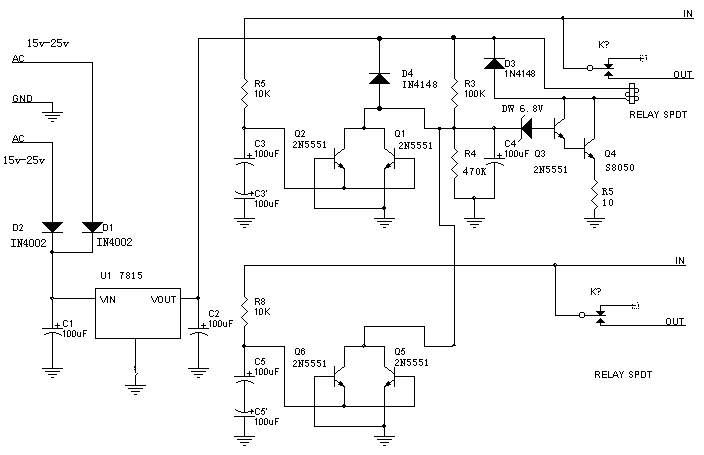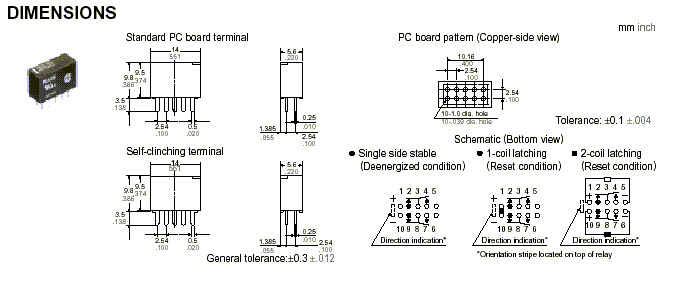The input capacitance of the three-terminal voltage regulator is determined according to the load. If a high-power relay with a very small DC resistance is used, a capacitor of more than 470UF should be used. Since the resistance of this relay is relatively large, the actual measurement is about 1K, which means that the current consumption of this circuit should be below 20MA. The 47UF capacitor used in the experiment can work normally. It is feasible to use a 100UF capacitor in the circuit. If this capacitor is too large, it will not be possible to cut off the connection between the load and the amplifier when shutting down, causing an impact on the headphones. Since the working current of this circuit is very small, it is OK to replace the three-terminal voltage regulator circuit with 78M15 or 78L15.
Schematic diagram:

The basic functions are:
1. Delayed connection of headphones after power on. According to the board I made, the headphones are connected after a delay of about 3-5 seconds after power on to protect the headphones from the power on current shock.
2. Power off after power off. Since the filter capacitor of the power supply part is selected to be relatively small, after power off, the connection between the headphones and the amplifier is almost disconnected at the same time to protect the headphones from the power off current shock.
3. Output DC voltage abnormal protection. After a simple experiment, when the output voltage of +1.5V appears at the output end of the amplifier, the connection can be disconnected within 1 second, and when the amplifier has a negative voltage output, the protection action voltage is relatively high.
After 3 hours, I finally soldered the protection circuit of the headphone amplifier. Due to the lack of components, the parameters were inconsistent with the schematic diagram above. Fortunately, the soldering was successful in one go. Note that the small black rectangle between the input and output terminals is the Japanese miniature relay, which is most suitable for protecting headphones. Of course, you can also use a large relay and use it as a speaker protection. The PCB board has been made according to the installation form of dual relays.
Relays used in the circuit:

The finished circuit board is quite small, right? The area of the PCB wrench is 10CM*4CM.
Previous article:[Photos] Making a beautiful sounding Class A amplifier
Next article:[Photo] LM1875 power amplifier circuit
- High signal-to-noise ratio MEMS microphone drives artificial intelligence interaction
- Advantages of using a differential-to-single-ended RF amplifier in a transmit signal chain design
- ON Semiconductor CEO Appears at Munich Electronica Show and Launches Treo Platform
- ON Semiconductor Launches Industry-Leading Analog and Mixed-Signal Platform
- Analog Devices ADAQ7767-1 μModule DAQ Solution for Rapid Development of Precision Data Acquisition Systems Now Available at Mouser
- Domestic high-precision, high-speed ADC chips are on the rise
- Microcontrollers that combine Hi-Fi, intelligence and USB multi-channel features – ushering in a new era of digital audio
- Using capacitive PGA, Naxin Micro launches high-precision multi-channel 24/16-bit Δ-Σ ADC
- Fully Differential Amplifier Provides High Voltage, Low Noise Signals for Precision Data Acquisition Signal Chain
- Innolux's intelligent steer-by-wire solution makes cars smarter and safer
- 8051 MCU - Parity Check
- How to efficiently balance the sensitivity of tactile sensing interfaces
- What should I do if the servo motor shakes? What causes the servo motor to shake quickly?
- 【Brushless Motor】Analysis of three-phase BLDC motor and sharing of two popular development boards
- Midea Industrial Technology's subsidiaries Clou Electronics and Hekang New Energy jointly appeared at the Munich Battery Energy Storage Exhibition and Solar Energy Exhibition
- Guoxin Sichen | Application of ferroelectric memory PB85RS2MC in power battery management, with a capacity of 2M
- Analysis of common faults of frequency converter
- In a head-on competition with Qualcomm, what kind of cockpit products has Intel come up with?
- Dalian Rongke's all-vanadium liquid flow battery energy storage equipment industrialization project has entered the sprint stage before production
- Allegro MicroSystems Introduces Advanced Magnetic and Inductive Position Sensing Solutions at Electronica 2024
- Car key in the left hand, liveness detection radar in the right hand, UWB is imperative for cars!
- After a decade of rapid development, domestic CIS has entered the market
- Aegis Dagger Battery + Thor EM-i Super Hybrid, Geely New Energy has thrown out two "king bombs"
- A brief discussion on functional safety - fault, error, and failure
- In the smart car 2.0 cycle, these core industry chains are facing major opportunities!
- The United States and Japan are developing new batteries. CATL faces challenges? How should China's new energy battery industry respond?
- Murata launches high-precision 6-axis inertial sensor for automobiles
- Ford patents pre-charge alarm to help save costs and respond to emergencies
- New real-time microcontroller system from Texas Instruments enables smarter processing in automotive and industrial applications
- How to make an elevator controller based on 8952 microcontroller?
- Interpretation of JTAG interface for embedded development ARM technology
- EEWORLD University ---- Jixin STM32 Smart Car
- Experience in using PWM of 28069 and 28377D of C28x series
- At 10:00 this morning, we invite you to listen to the award-winning live broadcast: ADI's digital active noise reduction headphone solution allows technology to calm us down~
- Common MOS tube models and parameter comparison table
- From terminals to architecture, TE Connectivity (TE) helps you connect to the 5G high-speed future. Watch the video and answer questions to win gifts!
- ST's latest evaluation activity! Get the first-hand experience of the NUCLEO_G431RB development board here
- Some points to note when designing CC2530 2.4G ZigBee low power PCB
- Unveiling the secrets of NB-IoT modules DRX, eDRX, and PSM (Part 1)

 Application Note AN-47 TOPSwitch-JX Family
Application Note AN-47 TOPSwitch-JX Family















 京公网安备 11010802033920号
京公网安备 11010802033920号